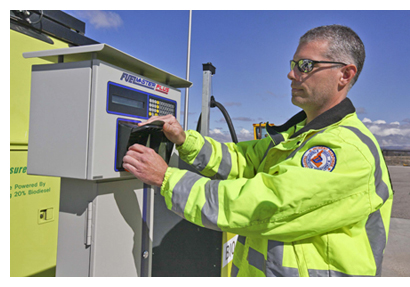

New cards to be used for fueling at ITD sites
Fueling instructions
|
Changes to the fueling process at ITD pumps throughout the state will improve operational efficiency and provide better inventory control, according to Maintenance Services Manager Steve Spoor and Fuel Systems Manager Jackie McCloughan.
Beginning May 21, operators of ITD vehicles will use a new ProKee fob at the department’s fueling sites. The fob will be included on the key ring of each ITD vehicle, McCloughan explains.
Drivers will use the new ProKee device at 64 ITD locations statewide. Fuel purchases at commercial vendors will require use of CommData fuel cards as in the past. Odometer readings will be required when refueling at any location, ITD-based or commercial.
Users will need to insert the fob into the FuelMaster card reader equipped at all ITD locations and follow the prompts displayed on the screen. A video prepared by the Office of Communications provides instructions on using the new fobs. Click here to watch the instructional video (ITD internal users).
ITD has used FuelMaster card readers to collect fuel data and monitor fuel inventories for several years, McCloughan explains. The use of fobs at fueling stations will enable the department to take advantage of the additional features available in the associated software.
The new system will provide higher quality data and better control over the fueling process. Instead of weekly reports that often lagged about two weeks behind, information about fuel consumption will be available in “near real time,” and allow easier reconciliation of available data.
McCloughan estimates the new process will save about 5,000 hours of staff time annually. The resulting personnel efficiency will free workers to apply their efforts to maintenance activities.
ITD vehicles consume approximately 2 million gallons of fuel annually, which translates to about $7.4 million based on current fuel prices. Achieving greater efficiency supports the goals of the department’s new strategic plan by reducing costs through innovation, process improvements and technology.
Published 5-11-2012